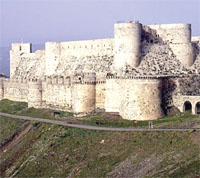
Seven days in Syria [Archives:2007/1032/Last Page]
March 12 2007
 |
For Yemen Times
As a tourist destination Syria, is often overlooked yet it has much to offer; from touring the ancient cities, magnificent ruins, and huge medieval forts to shopping for jewellery, spices, and antiques. Because the country is small and costs are cheap Syria can be enjoyed without bags of cash and months to spare.
Aleppo is Syria's second biggest city; it is a squat place with grey buildings and an exciting bustle to it. Just walking down the street people will call out and ask if you are enjoying your trip and if you need any assistance. Unlike other countries where tourism is a major industry, this friendliness has no ulterior motives; people are genuinely interested and helpful. Old Aleppo is a world heritage site, containing ancient and atmospheric covered souqs. You can easily get lost in the myriad of shops and passageways, containing everything from the exotic to the stomach turning. Even if you are not shopping it is a fascinating place. During evening prayer, when the mosques call out and the streets are quiet and bathed in a pale light, it is a special experience to walk along the avenues of the bazaar; you almost feel the weight of ages hanging over the place.
A true delight of the old city is the Turkish baths: The steam rooms are made from marble, and are adjacent to a large lavishly decorated reclining area. The reclining area is domed in the middle and contains chandeliers, eastern ornaments, and sofas on which to lie on after a relaxing sauna and massage. The finale includes being draped in hot towels and served tea in quintessentially Arabian luxury.
A two hour bus ride from Aleppo is the silk producing town of Hama, although there is not much to do here its pleasant ambience, parks, and huge water wheels, make it a good place to stay for excursions to the Crac des Chevaliers. The castle was built by Crusader knights in the middle of the 12th century, on the sight of an earlier Arabian fortress. It was a last remaining stronghold of the holy warriors but was given up after the great Muslim warlord Saladin laid siege to the place. Today the Crac des Chevaliers stands alone in its size and its entirety; Lawrence of Arabia said it was “the finest castle in the world”. It is certainly a place where childhood can be recaptured for a day; it would be difficult not to be captivated by exploring its dark arched interior and investigating the massive outside wall and turrets that have commanding views of all around.
Perhaps the most touristic destination of Syria is Palmyra; a ruined 2nd Century city in the middle of the desert. The city saw the Greek and Roman dynasties come and go, passed into Muslim hands and then was finally destroyed by an earthquake in 1089. The impressive ruins, especially that of the Temple of Bel, make for an interesting couple of days. The sunset from the Arab castle on the hill over the site is quite beautiful and gives a good perspective on how large the remains are. The town around the ruins has hotels and restaurants, where the evening can be spent eating, drinking, and talking.
Damascus is a three hour bus ride from Palmyra and Syria's enigmatic capital is not to be missed. Damascus has more of an international feel to it than anywhere else in Syria and is slightly less obliging in hospitality than the smaller Aleppo; but this doesn't make it any less fun. Damascus is a one off, it is said to be the oldest city on earth and with its run down charm and impressive monuments is an extremely interesting capital. It is a place were many people meet from all over the world and for all sorts of different reasons: It could be one day that you run into someone cycling from Istanbul to Cairo, or a business man buying antique watches from the mysterious shops surrounding the Umayyad Mosque. From wizened falafel sellers to couples driving to Cape Town; Damascus is full of interesting characters and stories that stay with you forever.
Most of Damascus' sights are concentrated in the old part of the city; the Souq al- Hamidiyya is the main covered market, leading at one end to the citadel and at the other to the Umayyad Mosque. The market is complete chaos; lots of stuff to buy and foods to try. The Umayyad Mosque is directly opposite the exit to the market. It is a lovely place, the architecture and golden mosaics adorning the courtyard of the mosque are a definite sight, and the atmosphere is very relaxed: Children play in the courtyard and chase the birds, women stand around in groups and chat, and on the inside the people at prayer are countered by people sleeping and talking quietly on the carpets.
Behind the mosque are the alleys and streets of the old town, and the restaurants and juice stores clustered around there, are a great place to rest after tramping around the sights. Damascus has a lot to offer visitors: museums, mosques, restaurants, and palaces; it is, like the whole of Syria, a very rewarding place to visit.
——
[archive-e:1032-v:14-y:2007-d:2007-03-12-p:lastpage]


